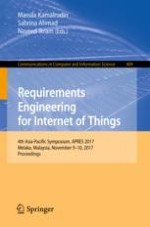2018 | OriginalPaper | Chapter
Eliciting Activity Requirements from Crowd Using Genetic Algorithm
Authors : Chunhui Wang, Wei Zhang, Haiyan Zhao, Zhi Jin
Published in: Requirements Engineering for Internet of Things
Publisher: Springer Singapore
Activate our intelligent search to find suitable subject content or patents.
Select sections of text to find matching patents with Artificial Intelligence. powered by
Select sections of text to find additional relevant content using AI-assisted search. powered by
